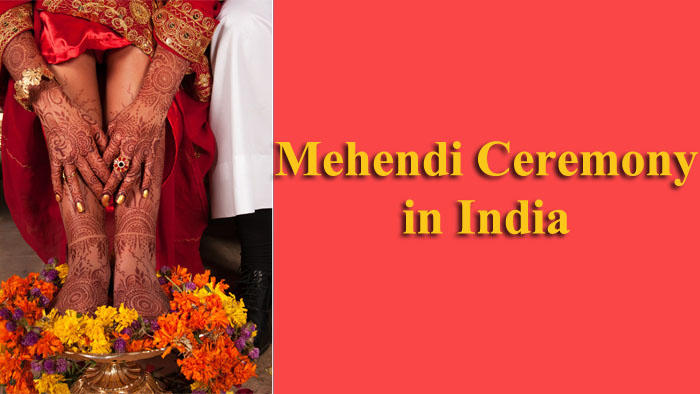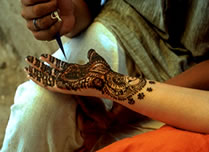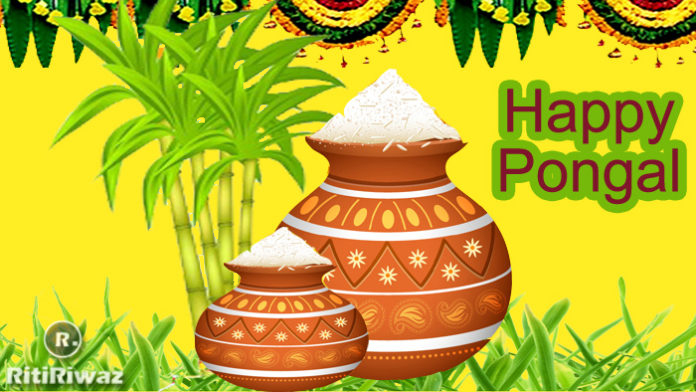Mehndi Ceremony in India

A traditional Indian wedding is one that lasts for many days. We have perhaps the most flamboyant and colorful weddings, which in my opinion, are not cached by any other community or society in the world. Whereas an average European wedding has no more than an average of 75 cards printed, we have an average of a whopping 300 cards per wedding per side. i.e. 300 from the bride’s side and 300 from the groom’s side. And when we get married we do not usually invite just a handful of selected people, we invite everyone and in some cases anyone!
Our weddings are not boring, as anyone who has ever attended an Indo/Pakistani will tell you, it is one big party, full of color song and dance, lasting over many days and in some cases weeks. The last four to five days leading up to the wedding day itself are all planned and organized with a whole array of activities on each of the evenings. We have many delightful and tasteful dishes on the preparation of the menu for which starts many days before the big day itself.
Many of our wedding traditions have now been taken up by the European or Western communities, such the decorating the house with lights and decorations a few days before the wedding, elaborate decoration of the wedding vehicle, be it a limousine, a Rolls Royce, or a horse-carriage, and of course not forgetting the application of Mehndi or Henna on the hands and feet, (and sometimes on many other places!) of all involved in the wedding.
Mehndi is not synonymous with the Western wedding but is now a huge business in the Western world with the likes of Madonna, Darryl Hanna, Prince, and Demi Moore to name just a few who have been seen in public with Mehndi tattoos on parts of their anatomies…and guess where they got the idea from?
Mehndi is a short-term tattoo, and not something you are lumbered with for the rest of your life, just because someone had dared you, or were perhaps drunk or thought it was a great idea at the time! This is a tattoo you can have as often as you like, wherever you like and it is totally safe, and only lasts for a few days. It is made of all-natural ingredients so you can be sure of not getting any harmful or cancerous elements in your skin.
The application of Mehndi in our culture is a sign of a joyous occasion, it is almost always used on celebratory occasions, such as Diwali, Eid, wedding, engagement, and so on. I myself have tried, on a few occasions to dabble with Mehndi patterns. I am sure we have all seen or know Mehndi artists who are totally brilliant. Many Mehndi artists are known to command fees from anywhere between 150 to 1500 USD just for one wedding. Not to mention the gifts such as sarees, jewelry, sweets, and other gifts that they expect! The ultimate idea is to make the bride, who is about to start a new life away from her family, feel like a princess.
Mehndi being applied at weddings used to be a small family affair with a handful of close family friends being invited to a small function at home a day or so before the wedding. But now it has gone public! It is not unusual to see a large hall being booked, with fancy floral arrangements, huge guest lists, and four or five-course meals, including a very loud (and sometimes annoying) DJ to entertain the guests. Mehndi traditionally used to be only applied to the bride but now the groom’s side also insists that it be applied to the groom too (any excuse for a party). It is at these ceremonies where the bride and groom are fed (and sometimes force-fed – but in all in good fun) with sweets or mithai, by almost all senior members present.
As well as being a lavishly colorful cosmetic, Mehndi is also supposed to have many healing qualities, many herbal doctors still recommend the use of Mehndi for some ailments, such as dry skin, and to hasten the healing of cuts and scratches. It also acts as a hair conditioner when applied to the hair and is also known to stop hair loss by strengthening the roots of the hair. Mehndi is alleged to have been brought to India by the Mughals in 12 A.D. after it had been used for centuries in the Middle East and Africa. Some of the earliest documentation of Mehndi comes from ancient Egypt, where it was used as a dye to stain the fingers and toes prior to mummification.
Also, Read…Mehndi – Custom and Designs

How to apply Mehndi
| 1) | Fill half a cup of natural ground henna powder. You can also add Tea, coffee, cloves, lemon, and sugar to enhance the colors and give a deeper shade, which will stay on for much longer, but these are purely optional. |
| 2) | Add it to a bowl that will not stain. My advice is to use an empty margarine container (so even if it does stain it doesn’t matter as you were going to throw it away anyway), the margarine container will also have a lid to help you store the mehndi and not let it dry so soon. |
| 3) | Add a small amount of boiling water to the bowl along with a few drops of Jasmine oil and mix until the paste it is similar in consistency to toothpaste. |
| 4) | Replace the lid on the container and allow the paste to settle for about 2-3 hours. |
| 5) | You can use almost anything to apply the mehndi, depending on the intricacy of your design, but the most commonly used are Mendhi cones. A soft Polythene can be used to make a cone. |
| 6) | About 3 hours is a decent length of time for allowing the mehndi paste to settle on your skin. |
| 7) | You can also apply lemon juice with sugar to keep the paste on your skin for longer and not let it flake away. |
| 8) | Once dried simply flake off the dried mehndi, but do not wash the applied area for at least 12 hours. |
Nowadays people just call the beautician and have beautiful Mendhi applied.
Mehndi or henna comes in many different shades or colors, ranging from reddish-orange to brown-black. Other colors available are usually artificially mixed and have dyes added to the natural henna, these usually do not last as long as natural Mehndi. Natural ones can last for anything between 1-2 weeks depending on the number of times the colored area is washed and on the body temperature. So if you need to get rid of the Mehndi quickly color wash the area often, and stay in hot temperature, as sweating will also increase its fading.
Ready-made Mehndi is readily available from most shops in most countries, you can also buy ready-made stencils to help you apply it. Usually, professional Mehndi artists are hired to apply Mehndi, but it can be great fun for the whole family if you do it yourself. So here is a step by step method of making and applying henna:






